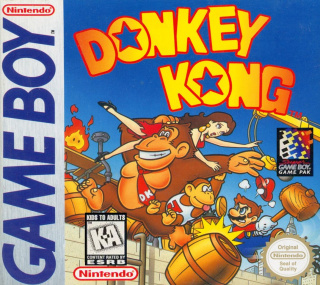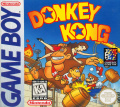Donkey Kong (Game Boy)
| Donkey Kong | ||||||||||||||||
|
Game Boy - USA - 1st edition. |
||||||||||||||||
|
Donkey Kong is a platform action game developed by Nintendo and Pax Softnica and published by Nintendo for the Game Boy on 1994-06-14. The game has direct support for the Super Game Boy. The game is part of the Donkey Kong series.
In the first four levels, the game appears to be a simple port of the original arcade game, but, once you finish the fourth stage, you discover that the game has been expanded to 100 unique stages, each with new monsters, items, and techniques. Some of the game mechanics come from the original arcade game, others were borrowed from Donkey Kong Jr., Yume Kojo: Doki Doki Panic, and a whole host are brand new for the game.
Contents
Personal
| Own? | Yes. Game Boy - USA - Loose cart. |
|---|---|
| Won? | Yes. |
| Finished | 2021-03-15. |
I remember seeing this game on lists of the best Game Boy games, so, I started playing it, but it just looked like a simple port of the arcade game. Since video game rating web sites frequently rank ports high on their lists just because the original was well-received, I stopped playing after only the first stage. However, sometime later, I was looking for another Game Boy game to play and saw this ranked as the best game on the platform, so I decided to look into it a bit deeper. After beating the fourth stage, I saw that it was actually a totally new game that just started like the original. I began playing the game properly, initially enjoying it quite a bit, but, as the game began to drag on, one very simple level after another, I started getting bored and began playing it in short sessions and finally beat it. After finishing it, I wondered how this could possibly receive the praise that it did since it's a fairly pedestrian platformer, but then I remember that it was for the Game Boy, which didn't have very many good platformers.
Review
| 5 | 5 | 4 | 4 | 6 |
Best Version: Game Boy
— This section contains spoilers! —
Good
- There are a whole lot of new levels with new items, monsters, and objects to manipulate the environment. And, the levels aren't just typical avoidance or attack levels like the original game, many of them include puzzle solving.
- The game rewards you for taking the more difficult path (and collecting Pauline's items) by giving you a minigame at the end of the stage to earn more lives.
- The game not only saves your progress, but it keeps track of your best scores on every level, which is nice.
- The combination of Donkey Kong and Donkey Kong Jr. levels added a nice amount of familiarity.
- I like how the game reminds you of the special moves in the cut scenes. This was certainly a more entertaining way to learn them than having to read the manual, although the manual it well-made also.
- The game has wonderful Super Game Boy support, which is always nice.
Bad
- I found the boss stages to be strangely easier than most of the regular stages leading up to them, which was a bit of a let down.
- The game gives you so many free lives, you'd have to be particularly awful to ever see a game over. In my very first play through, I maxed out the lives at 99. Part of the reason is that the most difficult stages give you a 1up early on, ensuring you can play the level forever until you beat it, but the real problem is with the minigames. The spinner is easy to match, and the slot machine is especially easy to game. You only get 1 life if you line up three rare hammers, but you also get 2 free lives simply by getting two very common Mario heads anywhere. So, even if your first slot is a hammer, you should still try for Mario heads rather than three hammers because you'll get more lives, and it's much easier to do.
- Although every stage is different, most of them are just minor variations on a theme and don't require much skill, so, even with 100 levels, by the end of the game, I was pretty bored.
- Though it's used well as a game mechanic, it doesn't make sense that you can't jump onto ladders, but you can jump onto vines.
- In the later stages, where I did start to die more frequently, I was annoyed with the long delay between dying and starting over.
- The final boss battle sees a huge ramp up in difficulty. While I don't mind it, it's a bit unfair to have such an easy game end with a vastly more difficult final boss.
- I'm a bit confused as to why Nintendo didn't give the game a different title, or, at the very least, a subtitle to differentiate it from the original game. Anyone seeing just the cover would probably assume it was a clone of the arcade game.
- Save the princess again? I get it, it was the plot of the original, but, with all they added to the game, something new could have been done with such a tired motif.
Ugly
- Nothing.
Media
All regions use the same fantastic cartoon art. Donkey Kong and DK Jr. both clearly enjoy aggravating Mario with the kidnapping of Pauline, and Mario is angry and violent as he bashes his way through the dangerous construction site. I like the reuse of the original arcade game's lettering.
Box Art
Documentation
Graphics
- spriters-resource.com/game_boy_gbc/dk - Sprites.
Videos
Play Online
Representation
| Strong female character? | Fail | There is only one woman, and she's a damsel in distress and reward. |
|---|---|---|
| Bechdel test? | Fail | The sole woman's only dialogue is "HELP!" |
| Strong person of color character? | Fail | Mario is the only human, and he's white. |
| Queer character? | Fail | There are no queer characters. |
Credits
| Roles | Staff |
|---|---|
| Executive Producer | Hiroshi Yamauchi |
| Producer | Shigeru Miyamoto |
| Directors | Masayuki Kameyama, Takao Shimizu |
| Main Programmers | Masayuki Hirashima, Yoshiaki Hoshino |
| Co-Programmer | Motoo Yasuma |
| C. G. Designers | Takaya Imamura, Hideo Kon, Kenta Usui |
| Sound Composer | Taisuke Araki |
| Course Designers | Masayuki Kameyama, Hideo Kon, Katsutomo Maeiwa, Kuniko Sakurai, Takao Shimizu, Kenji Umeda, Kenta Usui |
| Special Thanks To | Shigeki Yamashiro |
| Illustrator | Yoichi Kotabe |
| Manual Editor | Atsushi Tejima |
Titles
| Language | Native | Transliteration | Translation |
|---|---|---|---|
| English | Donkey Kong | ||
| Japanese | ドンキーコング | Donki Kongu | Donkey Kong |
Links
- Video Games
- 1994 Video Games
- Video games developed by Nintendo
- Video games developed by Softnica
- Video games published by Nintendo
- Game Boy Games
- Video Game Genre - Action
- Video Game Genre - Platformer
- Media Theme - Cartoon
- Software Distribution Model - Commercial
- Video Games I Own
- Video Games I've Beaten
- Video Game Rating - 5
- Video Game Graphics Rating - 4
- Video Game Sound Rating - 4
- Video games which can be played online
- Video games without a strong female character
- Video games that fail the Bechdel test
- Video games without a strong person of color character
- Video games without a queer character
- Video Game Prime Order - Action, Strategy, Adventure
- Trope - Damsel In Distress
- Trope - Women As Reward
- Grayscale Graphics








